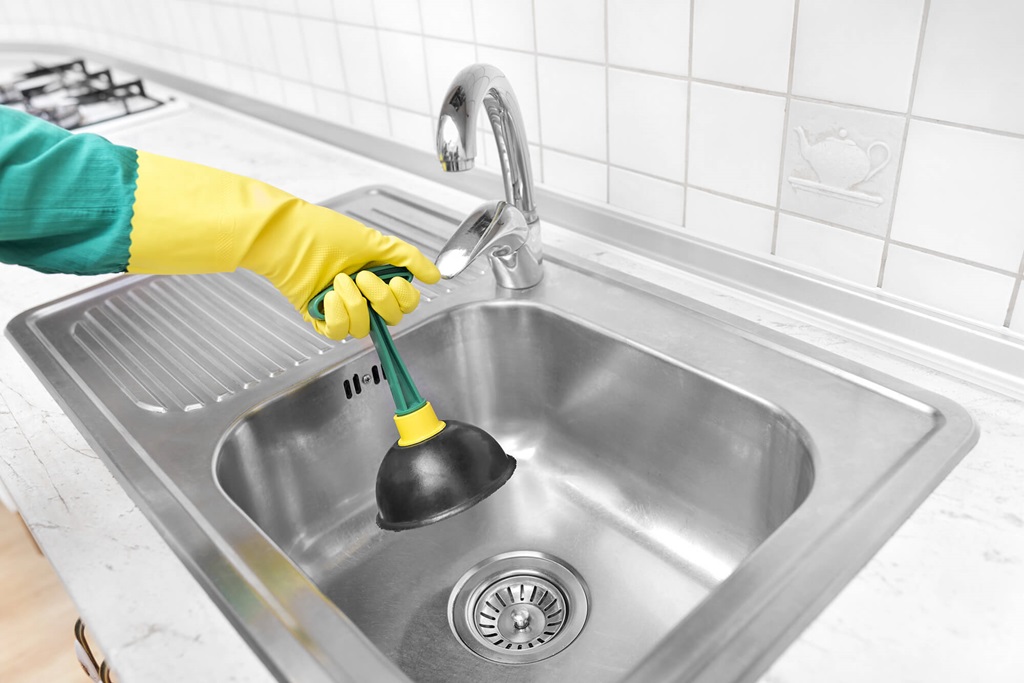Have you ever experienced a stubborn clog in your sink that just won’t budge, no matter how much you plunge or use chemical drain cleaners? It’s a frustrating situation that many homeowners have faced at some point. Fortunately, there’s a hidden gem in your plumbing system that can come to the rescue – the sink cleanout. In this guide, we’re going to dive deep into the world of sink cleanouts, exploring what they are, how to use them effectively, and why they’re your secret weapon against drain blockages.
The Sink Cleanout Unveiled
Before we get into the nitty-gritty of using a sink cleanout, let’s start with the basics. What exactly is a sink cleanout? Think of it as a special access point in your plumbing system, strategically placed to make your life easier when dealing with drain problems. It’s like having a trap door to the mysterious underworld of your pipes.
Imagine you’re the captain of a submarine, and your sink drain is your periscope. Sometimes, your periscope gets obstructed, and you can’t see clearly. That’s where the sink cleanout comes in – it’s your hatch to clear the way and ensure smooth sailing in your plumbing system.
Most sink cleanouts are found beneath the sink, close to the wall, and they usually have a screw-on or pop-off cap. These caps are typically made of plastic or metal and serve as the entry point for your sink’s drainage system.
When Should You Use a Sink Cleanout?
Now that you know what a sink cleanout is, the next question is: When should you use it? Sink cleanouts are your go-to solution when you encounter the following plumbing issues:
1. Stubborn Clogs
The most common reason to use a sink cleanout is when you have a clog that won’t budge. When your plunger and drain cleaners fail to clear the blockage, it’s time to roll up your sleeves and access the sink cleanout.
Think of it like trying to push a boulder out of your path with your bare hands. It’s time to bring in the heavy machinery – the sink cleanout.
2. Slow Drainage
If your sink is draining slowly, it might be a sign of a partial blockage. Slow drainage can be a precursor to a full-blown clog, so addressing it early is crucial. The sink cleanout allows you to inspect and clear any potential obstructions before they become major problems.
Imagine you’re in a race, and your competitor is inching ahead. You don’t wait until they’ve crossed the finish line; you take action to catch up. Similarly, don’t wait for a total blockage – tackle the slow drainage issue head-on with your trusty sink cleanout.
3. Foul Odors
Sometimes, unpleasant odors can waft up from your sink, indicating a buildup of organic matter or debris in your pipes. This not only smells bad but can also be a breeding ground for bacteria. A sink cleanout helps you access and clean the areas where these odors originate.
Picture your sink as a perfume shop. If an unpleasant smell starts emanating, you’d want to find the source and get rid of it ASAP, right? Your sink cleanout is like your olfactory detective tool for plumbing mysteries.
How to Use a Sink Cleanout: Step-by-Step Guide
Now that you know when to use a sink cleanout, let’s dive into the practical steps of how to use it effectively. It’s like having a secret weapon in your plumbing arsenal, and knowing how to wield it can save you time and money on plumbing repairs.
Step 1: Prepare Your Tools
Before you start, gather the tools you’ll need:
- A bucket or container (to catch any water or debris)
- A pair of rubber gloves (to protect your hands)
- A pipe wrench or pliers (for removing the cleanout cap)
- A flashlight (to illuminate the dark depths of your plumbing)
Think of your tools as your trusty sidekicks, ready to assist you on your plumbing adventure.
Step 2: Locate the Sink Cleanout
As mentioned earlier, most sink cleanouts are located beneath the sink, close to the wall. Look for a small cap or plug with a hexagonal or square shape. It’s usually white or gray in color, but this can vary.
Imagine you’re on a treasure hunt, and the sink cleanout is your hidden chest of plumbing treasures. You’ve got your map (knowledge), and now you’re on the hunt for the ‘X’ that marks the spot.
Step 3: Clear the Area
Clear any objects or clutter from beneath the sink to give yourself plenty of working space. You don’t want anything in your way while you’re trying to access the cleanout.
Think of it like preparing a canvas for a masterpiece. Clear the clutter, so you have a clean, blank slate to work on.
Step 4: Put on Your Gloves
Now it’s time to gear up. Put on your rubber gloves to protect your hands from any dirt, grime, or potential hazards you might encounter during the process.
Your gloves are like your armor in this plumbing adventure. They shield you from the mess and keep you in control.
Step 5: Remove the Cleanout Cap
Using your pipe wrench or pliers, carefully unscrew or pop off the cleanout cap. Be prepared for a little water or debris to come gushing out. That’s why you have your bucket or container handy to catch it.
Think of this step as opening the door to the unknown. You’re about to reveal the mysteries lurking within your plumbing system.
Step 6: Inspect and Clear
Shine your flashlight into the cleanout to inspect the interior of the pipe. Look for any visible obstructions, such as hair, food particles, or other debris. Use a plumbing snake or a long, flexible brush to gently dislodge and remove the blockage.
Imagine you’re a detective solving a crime – in this case, the crime is a clogged sink. Your flashlight is your magnifying glass, and your snake or brush is your trusty tool for removing evidence (debris).
Step 7: Reassemble and Test
Once you’re satisfied that you’ve cleared the blockage, reattach the cleanout cap securely. Make sure it’s snug but not over-tightened to avoid damaging the threads. With the cap back in place, turn on the water and check if the sink is draining properly.
Think of this step as putting the finishing touches on a puzzle. You’ve solved the mystery, and now it’s time to see if everything fits back together perfectly.
Why Use a Sink Cleanout?
You might be wondering why it’s worth the effort to use a sink cleanout when you can simply call a plumber or rely on chemical drain cleaners. Here are some compelling reasons why using a sink cleanout is a smart choice:
1. Cost-Effective
Hiring a plumber can be expensive, especially for minor plumbing issues like clogs. By using a sink cleanout, you can often resolve the problem yourself, saving money on professional services.
Think of it as fixing a leaky faucet. You wouldn’t call a plumber for a tiny drip, would you? Similarly, a sink cleanout empowers you to tackle small plumbing issues on your own.
2. Environmentally Friendly
Chemical drain cleaners contain harsh chemicals that can be harmful to the environment. Using a sink cleanout allows you to clear clogs without resorting to chemicals, making it a greener and more eco-friendly option.
Imagine you’re choosing between two paths: one leads to a toxic wasteland, and the other to a lush, green forest. Using a sink cleanout is like taking the eco-friendly path, preserving the environment for future generations.
3. Quick Resolution
When you have a clog or slow drainage, you want the problem resolved as quickly as possible. Waiting for a plumber’s appointment can be time-consuming. With a sink cleanout, you can address the issue immediately.
Think of it like having a superhero on call. When trouble strikes, you don’t want to wait for them to arrive; you want to spring into action yourself.
4. Preventative Maintenance
Regularly using your sink cleanout can help prevent major plumbing disasters. By addressing minor clogs and slow drainage promptly, you reduce the risk of larger, more expensive issues down the road.
Imagine your plumbing system as a car. You wouldn’t wait for your engine to seize up before getting an oil change, right? Regular sink cleanout use is like changing your plumbing system’s oil, keeping it running smoothly.
In conclusion
The sink cleanout is your trusty sidekick in the world of plumbing. It’s there when you need it most, ready to help you tackle clogs, slow drainage, and foul odors. By following the steps outlined in this guide, you can become a plumbing superhero in your own home, saving time and money while keeping your pipes clear and your sinks flowing smoothly. So, the next time you face a plumbing challenge, don’t hesitate to uncap the sink cleanout and take matters into your own hands.
FAQs
- How often should I use the sink cleanout?
- You don’t need to use the sink cleanout regularly as part of routine maintenance. However, if you encounter a stubborn clog, slow drainage, or foul odors, that’s the time to use it. It’s a reactive tool rather than a proactive one.
- Can I use chemical drain cleaners before using the sink cleanout?
- It’s generally not recommended to use chemical drain cleaners before using the sink cleanout. These chemicals can be harsh and may not be effective at removing certain types of clogs. It’s safer to start with the cleanout method and resort to chemicals as a last resort.
- What if the sink cleanout doesn’t solve the problem?
- If the sink cleanout doesn’t resolve the issue, or if you’re uncomfortable performing the procedure, it’s advisable to seek professional plumbing assistance. There may be a more complex problem in your plumbing system that requires expert attention.
- Is there a difference between sink cleanouts in the kitchen and bathroom?
- While the basic concept of sink cleanouts is the same, there may be slight variations in their design and location between the kitchen and bathroom. In general, kitchen sink cleanouts are often located beneath the sink, while bathroom sink cleanouts might be hidden behind a wall access panel or beneath the vanity.
- Can I prevent clogs from happening in the first place?
- Yes, you can take preventive measures to reduce the likelihood of clogs. Avoid disposing of grease or large food particles down the kitchen sink, use drain screens to catch hair in the bathroom sink, and periodically flush your drains with hot water to clear minor build-ups.








